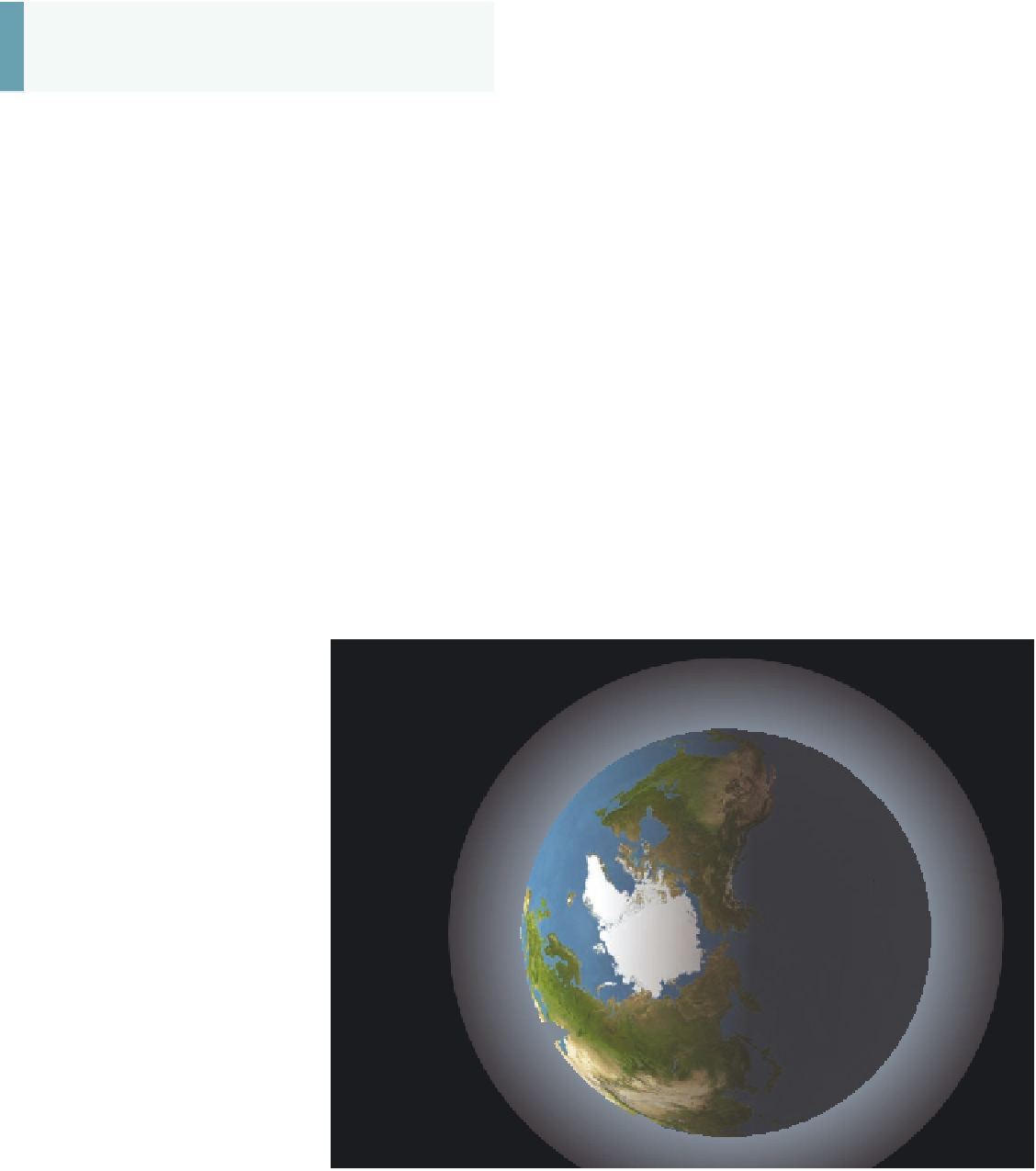Geoscience Reference
In-Depth Information
either by clouds, water, or the surface. The remaining 31% of
shortwave energy is reflected directly back into space due to
albedo or scattering. For the global radiation budget to remain
in balance, therefore, Earth must emit all the absorbed energy
back to space, which it does in longwave form. This release,
plus the 31% of reflected shortwave radiation, keeps the system
balanced. Earth's average temperature is moderated because
greenhouse gases such as CO
2
and water vapor trap a small
amount of longwave radiation.
Aside from the amount of longwave energy that is trapped
by the atmosphere, the bulk of it is lost in a way that balanc-
es the global radiation budget. This balance is accomplished
in a variety of ways (see Figure 4.21). The majority (45%) of
longwave energy is lost to space by direct radiation from the
surface. This form of loss does not happen evenly across the
Earth's surface, but rather has a distinct geographic pattern of
its own, with lower latitudes emitting more energy than higher
latitudes (Figure 4.22). This pattern makes sense, of course, be-
cause low latitudes receive more shortwave radiation than high
latitudes. In addition to direct energy loss from the surface, 21%
of longwave energy is lost directly by radiation from the atmo-
sphere and another 3% is emitted by ozone.
Although the long-term energy budget for Earth balances
on a global scale, it can vary markedly over the short term in
different regions, due to the interaction of various environ-
mental factors. Because of this variability, certain locations
KEY CONCEPTS TO REMEMBER
ABOUT HOW SOLAR RADIATION
FLOWS ON EARTH
1.
Once solar radiation reaches the atmosphere, it begins
to flow along several different pathways. Some of it
flows directly to the surface, whereas other parts are
reflected off clouds or scattered by particulates.
2.
Insolation that reaches the surface is either absorbed or
reflected (a function of albedo).
3.
Radiation that is absorbed is re-radiated as longwave
radiation.
4.
The amount of energy reflected or absorbed depends
in large part on the angle of incidence, which, in turn,
varies by latitude and season.
The global Radiation budget
To fit this discussion into a coherent model, think of Earth's
energy flow as being analogous to money that flows in and out
of your bank account. Sometimes you have a net surplus of cash
because you have made a lot of money, whereas at other times
you might even be a little in the hole
because you have spent more than
you earn. Like your bank account,
the Earth's
radiation budget
refers
to the balance between incoming
(shortwave) radiation and outgoing
radiation, which is either re-radiated
through reflecting and scattering pro-
cesses described earlier or released
from the Earth in longwave form.
The difference between incoming
and outgoing values is the
net ra-
diation
. For Earth as a whole, the
long-term radiation budget must be
balanced; otherwise, Earth would
become progressively warmer or
cooler. This balance is achieved be-
cause incoming radiation flows are
matched by outgoing flows.
Figure 4.21 illustrates the fun-
damental nature of the Earth's ra-
diation budget by incorporating the
data from Figure 4.16. To simplify
the concept, remember that solar en-
ergy is in the form of shortwave ra-
diation and that 69% of it is actually
absorbed by some aspect of Earth,
Shortwave energy
Longwave energy
Total reflectivity (albedo)
of Earth = 31%
Radiated by
atmosphere, 21%
Reflected to space
by clouds, 21%
Reflected by surface, 3%
Scattered to space
by dust, 7%
Radiated by
surface, 45%
Total longwave energy
lost by Earth to space
in some way = 69%
Absorbed by
clouds, 3%
Absorbed by
ozone, 3%
Absorbed directly
by atmosphere,
18%
Radiated by
ozone, 3%
Greenhouse
effect, 3%
Reflected radiation
down to Earth (indirect
radiation), 20%
Total shortwave energy
absorbed by Earth in
some way = 69%
Direct radiation
reaching Earth, 25%
Figure 4.21 The global radiation budget.
The difference between incoming (shortwave)
radiation and outgoing (longwave) radiation must be balanced; otherwise, the temperature of
Earth would either cool or warm dramatically.
Radiation budget
The overall balance between incoming and
outgoing radiation on Earth.
net radiation
The difference between incoming and outgoing
flows of radiation.











































